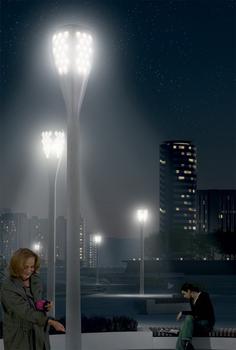The trend of intelligent LED lights
 In the current society, some people still clamor with the standard of LED lighting, price and other issues and doubt its promotion and application prospects, the reporter found on June 9th at the Asia LED Summit Forum 2012 in Guangzhou Pazhou Complex. What the industry experts are concerned about is no longer the issue of whether LED can be popularized because it is an indisputable fact. Pursuit of “better light†is a common topic that many speakers focus on.
In the current society, some people still clamor with the standard of LED lighting, price and other issues and doubt its promotion and application prospects, the reporter found on June 9th at the Asia LED Summit Forum 2012 in Guangzhou Pazhou Complex. What the industry experts are concerned about is no longer the issue of whether LED can be popularized because it is an indisputable fact. Pursuit of “better light†is a common topic that many speakers focus on. "It is enough if light can be taken wherever it is needed." This is Mr. of OSRAM Opto Semiconductors Asia Limited. Paul Jeziiorowski is a classic word. He believes that there will be no light pollution. Mr. PaulJeziorowski, for example, said that he recently used six one-watt LEDs in India, with a solar device, to drive a streetlight, and it was still very bright.
Kiharu Hiroshi, Deputy Director of the LED Development Center for Lighting Co., Ltd. of Nichia Chemical Industry Co., Ltd., reports on the latest LED light auto-dimming system that automatically adjusts the brightness according to the external environment in Nisya's report on "The Latest Technology of Lighting LEDs." As an example, it elaborated that “in addition to high light efficiency, light quality, lightness of size, and intelligent control systems will be the focus of future LED lighting development.â€
Hiroki Hiroshi said that the benefits of LEDs are not only because of its large amount of lumens, but also because of its ability to shine according to the surrounding environment. If the surrounding environment is bright, the light it emits will be reduced to achieve the purpose of environmental protection; if the outside world is dark, the street will become brighter at midnight and it has sensor functions. According to the degree of light outside to adjust, this function is also achieved through the LED. He emphasized that no matter what we do now, we must consider the surrounding environment and take people as our center. LED manufacturers
finllyLED
Philips Marketing Director Mr. RayChock's report "Philosophically Analyzing LED Related Applications and Values" expressed the same view. He believes that "the future of LED lighting is not to bring higher light efficiency, but better light." He pointed out that lighting quality has a certain influence on people's spirit. Whether conditioned reflexes or stimuli, visual stimuli have reached more than 80% of people's emotional stimuli. In a different light environment, people's emotions can also change subtlely and uncontrollably. Photodiode
Patch Diode
Mr. RayChock believes that LED, as the latest environmental protection technology, should be designed with full consideration of the specific effects of light on human emotions. He took the light environment of schools, hospitals, offices, shops and other places as an example and cited the benefits of intelligent LED lighting. Among them, lighting can be used for medical purposes, and it can be used to manage people's physical diseases through changes in color; school lighting requires light color uniformity; for office space, light color changes can be made according to different working hours, so that employees from morning to night Stay relaxed and full of energy; for the store, you can use intelligent lighting to create an atmosphere that allows customers to stay and forget.
Mr. RayChock also proposed that "in the future to achieve intelligent lighting, we should establish key technical indicators, and we must fully consider the lowest-cost LED lighting solutions to submit the highest standards."
For LED companies, 2012 will be a year in which challenges and opportunities coexist: On the one hand, LED industry upstream epitaxial wafers, chip overcapacity, the end market demand development is slow, prices and gross margins decreased significantly; on the other hand, incandescent At the beginning of implementation, the application of LED in green buildings and other application markets will bring huge opportunities for the industry. How do LED-producing countries drive their development in the LED industry that is competing with each other? In the LED war, how should companies respond? Will price wars be adopted to gain market share, or will LED quality be improved, brand promotion promoted, or emerging markets cultivated? The wonderful views of many experts in this forum have brought us very useful enlightenment for those who are in this war.
G23 LED Tube Light, unique and elegant design, graceful appearance, easy for installation and adjustment, this is our product`s advantage. Fits to universal socket base and can replace CFLs downlight without changing ballast, Unique structure ensure optimal cooling effect and light effect. High-end and gorgeous product with beautiful design. Frosted glass cover for option, ident shape of glass to reach anti-glare effect. Excellent thermal management ensure long lifetime of. Commercial lighting and house lighting are available. All the LED Tube Light here with CE, RoHS approval.
*Related Products:outdoor lighting,g23 led tube light,indoor lighting.
G23 Tubes ,G23 Tubes With Sensor Bright,G23 Led Tube 18W,11W G23 Tubes
SHENZHEN KEHEI LIGHTING TECHNOLOGY CO.LTD , https://www.keheiled.com